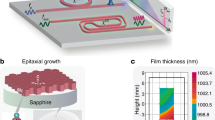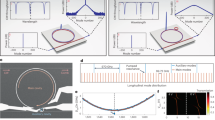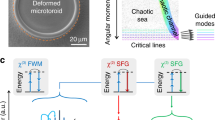Abstract
Earth-like planets, dark energy and variability of fundamental physical constants can be discovered by observing wavelength shifts in the optical spectra of astronomical objects1,2,3,4,5. These wavelength shifts are so tiny that exquisitely accurate and precise wavelength calibration of astronomical spectrometers is required. Laser frequency combs, broadband spectra of laser lines with absolutely known optical frequencies, are uniquely suited for this purpose6,7,8,9,10,11,12,13, provided their lines are resolved by the spectrometer. Generating such astronomical laser frequency combs (‘astrocombs’) remains challenging. Here, a microphotonic astrocomb is demonstrated via temporal dissipative Kerr solitons14,15,16 in photonic-chip-based silicon nitride microresonators17, directly providing a spurious-free spectrum of resolvable calibration lines. Sub-harmonically driven by temporally structured light18, the astrocomb is stabilized to a frequency standard, resulting in absolute calibration with a precision of 25 cm s–1 (radial velocity equivalent), relevant for Earth-like planet detection and cosmological research. The microphotonic technology can be extended in spectral span17,19,20,21,22,23,24, further boosting the calibration precision.
This is a preview of subscription content, access via your institution
Access options
Access Nature and 54 other Nature Portfolio journals
Get Nature+, our best-value online-access subscription
$29.99 / 30 days
cancel any time
Subscribe to this journal
Receive 12 print issues and online access
$209.00 per year
only $17.42 per issue
Buy this article
- Purchase on Springer Link
- Instant access to full article PDF
Prices may be subject to local taxes which are calculated during checkout



Similar content being viewed by others
Data availability
The data that support the plots within this paper and other findings of this study are available from the corresponding author upon reasonable request.
References
Mayor, M. & Queloz, D. A Jupiter-mass companion to a solar-type star. Nature 378, 355–359 (1995).
Lovis, C. et al. An extrasolar planetary system with three Neptune-mass planets. Nature 441, 305–309 (2006).
Uzan, J.-P. The fundamental constants and their variation: observational and theoretical status. Rev. Mod. Phys. 75, 403–455 (2003).
Murphy, M. T. et al. High-precision wavelength calibration of astronomical spectrographs with laser frequency combs. Mon. Not. R. Astron. Soc. 380, 839–847 (2007).
Liske, J. et al. Cosmic dynamics in the era of Extremely Large Telescopes. Mon. Not. R. Astron. Soc. 386, 1192–1218 (2008).
Steinmetz, T. et al. Laser frequency combs for astronomical observations. Science 321, 1335–1337 (2008).
Li, C.-H. et al. A laser frequency comb that enables radial velocity measurements with a precision of 1 cm s–1. Nature 452, 610–612 (2008).
Wilken, T. et al. A spectrograph for exoplanet observations calibrated at the centimetre-per-second level. Nature 485, 611–614 (2012).
Ycas, G. G. et al. Demonstration of on-sky calibration of astronomical spectra using a 25 GHz near-IR laser frequency comb. Opt. Express 20, 6631–6643 (2012).
Glenday, A. et al. Operation of a broadband visible-wavelength astro-comb with a high-resolution astrophysical spectrograph. Opt. Express 2, 250–254 (2015).
Yi, X. et al. Demonstration of a near-IR line-referenced electro-optical laser frequency comb for precision radial velocity measurements in astronomy. Nat. Commun. 7, 10436 (2016).
McCracken, R. et al. Wavelength calibration of a high resolution spectrograph with a partially stabilized 15-GHz astrocomb from 550 to 890 nm. Opt. Express 25, 6450–6460 (2017).
McCracken, R. A., Charsley, J. M. & Reid, D. T. A decade of astrocombs: recent advances in frequency combs for astronomy [Invited]. Opt. Express 25, 15058 (2017).
Leo, F. et al. Temporal cavity solitons in one-dimensional Kerr media as bits in an all-optical buffer. Nat. Photon. 4, 471–476 (2010).
Herr, T. et al. Temporal solitons in optical microresonators. Nat. Photon. 8, 145–152 (2014).
Kippenberg, T. J., Lipson, M., Gaeta, A. & Gorodetsky, M. G. Dissipative Kerr solitons in optical microresonators. Science 361, eaan8083 (2018).
Brasch, V. et al. Photonic chip-based optical frequency comb using soliton Cherenkov radiation. Science 351, 357–360 (2016).
Obrzud, E., Lecomte, S. & Herr, T. Temporal solitons in microresonators driven by optical pulses. Nat. Photon. 11, 600–607 (2017).
Del’Haye, P. et al. Octave spanning tunable frequency comb from a microresonator. Phys. Rev. Lett. 107, 063901 (2011).
Okawachi, Y. et al. Octave-spanning frequency comb generation in a silicon nitride chip. Opt. Lett. 36, 3398–3400 (2011).
Xue, X. et al. Mode-locked dark pulse Kerr combs in normal-dispersion microresonators. Nat. Photon. 9, 594–600 (2015).
Li, Q. et al. Stably accessing octave-spanning microresonator frequency combs in the soliton regime. Optica 4, 193–203 (2016).
Pfeiffer, M. H. P. et al. Octave-spanning dissipative Kerr soliton frequency combs in Si3N4 microresonators. Optica 4, 684–691 (2017).
Lee, S. H. et al. Towards visible soliton microcomb generation. Nat. Commun. 8, 1295 (2017).
Telle, H. R. et al. Carrier-envelope offset phase control: a novel concept for absolute optical frequency measurement and ultrashort pulse generation. Appl. Phys. B 69, 327–332 (1999).
Jones, D. J. et al. Carrier-envelope phase control of femtosecond mode-locked lasers and direct optical frequency synthesis. Science 288, 635–639 (2000).
Udem, T., Holzwarth, R. & Hänsch, T. W. Optical frequency metrology. Nature 416, 233–237 (2002).
Cundiff, S. T. & Ye, J. Colloquium: femtosecond optical frequency combs. Rev. Mod. Phys. 75, 325–342 (2003).
Chang, G., Li, C.-H., Phillips, D. F., Walsworth, R. L. & Kärtner, F. X. Toward a broadband astro-comb: effects of nonlinear spectral broadening in optical fibers. Opt. Express 18, 12736–12747 (2010).
Chang, G. et al. Optimization of filtering schemes for broadband astro-combs. Opt. Express 20, 24987–25013 (2012).
Probst, R. A. et al. Nonlinear amplification of side-modes in frequency combs. Opt. Express 21, 11670–11687 (2013).
Beha, K., Cole, D. C., Del’Haye, P., Coillet, A. & Diddams, S. A. Electronic synthesis of light. Optica 4, 406–411 (2017).
Torres-Company, V. & Weiner, A. M. Optical frequency comb technology for ultra-broadband radio-frequency photonics. Laser Photon. Rev. 8, 368–393 (2014).
Del’Haye, P. et al. Optical frequency comb generation from a monolithic microresonator. Nature 450, 1214–1217 (2007).
Savchenkov, A. A. et al. Tunable optical frequency comb with a crystalline whispering gallery mode resonator. Phys. Rev. Lett. 101, 093902 (2008).
Kippenberg, T. J., Holzwarth, R. & Diddams, S. A. Microresonator-based optical frequency combs. Science 332, 555–559 (2011).
Suh, M.-G., Yang, Q.-F., Yang, K. Y., Yi, X. & Vahala, K. Microresonator soliton dual-comb spectroscopy. Science 354, 600–603 (2016).
Grudinin, I. S. et al. High-contrast Kerr frequency combs. Optica 4, 434–437 (2017).
Cole, D. C., Lamb, E. S., Haye, P. D., Diddams, S. A. & Papp, S. B. Soliton crystals in Kerr resonators. Nat. Photon. 11, 671–676 (2017).
Joshi, C. et al. Thermally controlled comb generation and soliton mode-locking in microresonators. Opt. Lett. 41, 2565–2568 (2016).
Wang, P.-H. et al. Intracavity characterization of micro-comb generation in the single-soliton regime. Opt. Express 24, 10890–10897 (2016).
Pavlov, N. G. et al. Soliton dual frequency combs in crystalline microresonators. Opt. Lett. 42, 514–517 (2017).
Weiner, A. M. Cavity solitons come of age. Nat. Photon. 11, 533–535 (2017).
Levy, J. S. et al. CMOS-compatible multiple-wavelength oscillator for on-chip optical interconnects. Nat. Photon. 4, 37–40 (2010).
Pfeiffer, M. H. P. et al. Photonic Damascene process for integrated high-Q microresonator based nonlinear photonics. Optica 3, 20–25 (2016).
Pfeiffer, M. H. P. et al. Photonic Damascene process for low-loss, high-confinement silicon nitride waveguides. IEEE J. Sel. Top. Quantum Electron. 24, 6101411 (2018).
Jang, J. K., Erkintalo, M., Coen, S. & Murdoch, S. G. Temporal tweezing of light through the trapping and manipulation of temporal cavity solitons. Nat. Commun. 6, 7370 (2015).
Carmon, T., Yang, L. & Vahala, K. J. Dynamical thermal behavior and thermal self-stability of microcavities. Opt. Express 12, 4742–4750 (2004).
Baudrand, J. & Walker, G. A. H. Modal noise in high-resolution, fiber-fed spectra: a study and simple cure. Publ. Astron. Soc. Pac. 113, 851–858 (2001).
Oliva, E. et al. The GIANO spectrometer: towards its first light at the TNG. In Proc. SPIE 8446, 84463T (2012).
Bouchy, F., Pepe, F. & Queloz, D. Fundamental photon noise limit to radial velocity measurements. Astron. Astrophys. 374, 733–739 (2001).
Redman, S. L., Lawler, J. E., Nave, G., Ramsey, L. W. & Mahadevan, S. The infrared spectrum of uranium hollow cathode lamps from 850 nm to 4000 nm: wavenumbers and line identifications from Fourier transform spectra. Astrophys. J. 195, 24 (2011).
Suh, M.-G. et al. Searching for exoplanets using a microresonator astrocomb. Nat. Photon. https://doi.org/10.1038/s41566-018-0312-3 (2018).
Acknowledgements
This work was supported by the Swiss National Science Foundation (grant nos. 166108, 16864, 165933), the NCCR-PlanetS and NCCR-PlanetS Technology Platform, the NCCR-QSIT (51NF40-160591), the Canton of Neuchatel and the INAF Progetto Premiale WOW. T.J.K. acknowledges additional support by the Air Force Office of Scientific Research, Air Force Material Command, USAF under award no. FA9550-15-1-0099, and the Defense Advanced Research Projects Agency (DARPA), Defense Sciences Office (DSO) under contract no. HR0011-15-C-0055. All samples were fabricated in the Center for Micro-Nanotechnology CMI at EPFL. D. F. Phillips and the Havard-Smithsonian Center for Astrophysics’ astrocomb team are acknowledged for providing the GPS-disciplined atomic clock.
Author information
Authors and Affiliations
Contributions
E.O., S.K., S.L. and T.H. designed and implemented the microphotonic astrocomb. E.O., M.R., A.H. and T.H. performed the experiment and analysed the data. M.H.A., J.L., M.G. and T.J.K. designed, fabricated and provided the microresonator. B.C., F.W., F.P. and F.B. designed and implemented the light-coupling interface to the spectrometer. M.C., A.G. and E.M. provided critical support in connecting the astrocomb to the spectrometer as well as spectrometer operation. T.H. conceived and supervised the work. All authors participated in writing the manuscript.
Corresponding author
Ethics declarations
Competing interests
E.O., S.L. and T.H. are inventors in a patent application concerning driving a microresonator with temporally structured light that has been filed by CSEM. T.H. and T.J.K. are co-inventors in a patent application in the technical field. T.J.K. is co-inventor of patents owned by the Max-Planck Society and EPFL in the technical field. M.G. and T.J.K. are co-founders of Ligentec, a start-up company that is engaged in making Si3N4 nonlinear photonic chips available via foundry service.
Additional information
Publisher’s note: Springer Nature remains neutral with regard to jurisdictional claims in published maps and institutional affiliations.
Supplementary information
Supplementary Information
This file contains more information on the stability of the microphotonic astrocomb, the GIANO-B spectrometer and the impact of photon noise on spectrometer calibration.
Rights and permissions
About this article
Cite this article
Obrzud, E., Rainer, M., Harutyunyan, A. et al. A microphotonic astrocomb. Nature Photon 13, 31–35 (2019). https://doi.org/10.1038/s41566-018-0309-y
Received:
Accepted:
Published:
Issue Date:
DOI: https://doi.org/10.1038/s41566-018-0309-y
This article is cited by
-
Ultrashort dissipative Raman solitons in Kerr resonators driven with phase-coherent optical pulses
Nature Photonics (2024)
-
Synthetic reflection self-injection-locked microcombs
Nature Photonics (2024)
-
Parametrically driven pure-Kerr temporal solitons in a chip-integrated microcavity
Nature Photonics (2024)
-
Atom-referenced and stabilized soliton microcomb
Science China Physics, Mechanics & Astronomy (2024)
-
Breaking the efficiency limitations of dissipative Kerr solitons using nonlinear couplers
Science China Physics, Mechanics & Astronomy (2024)



